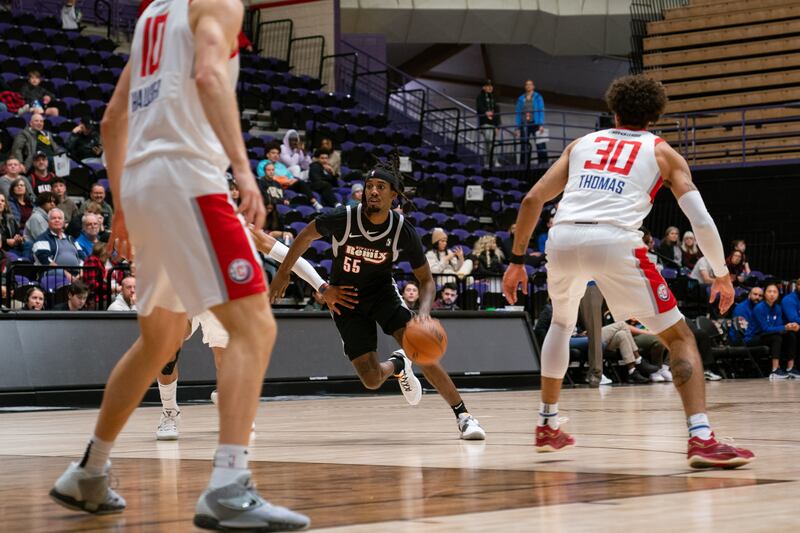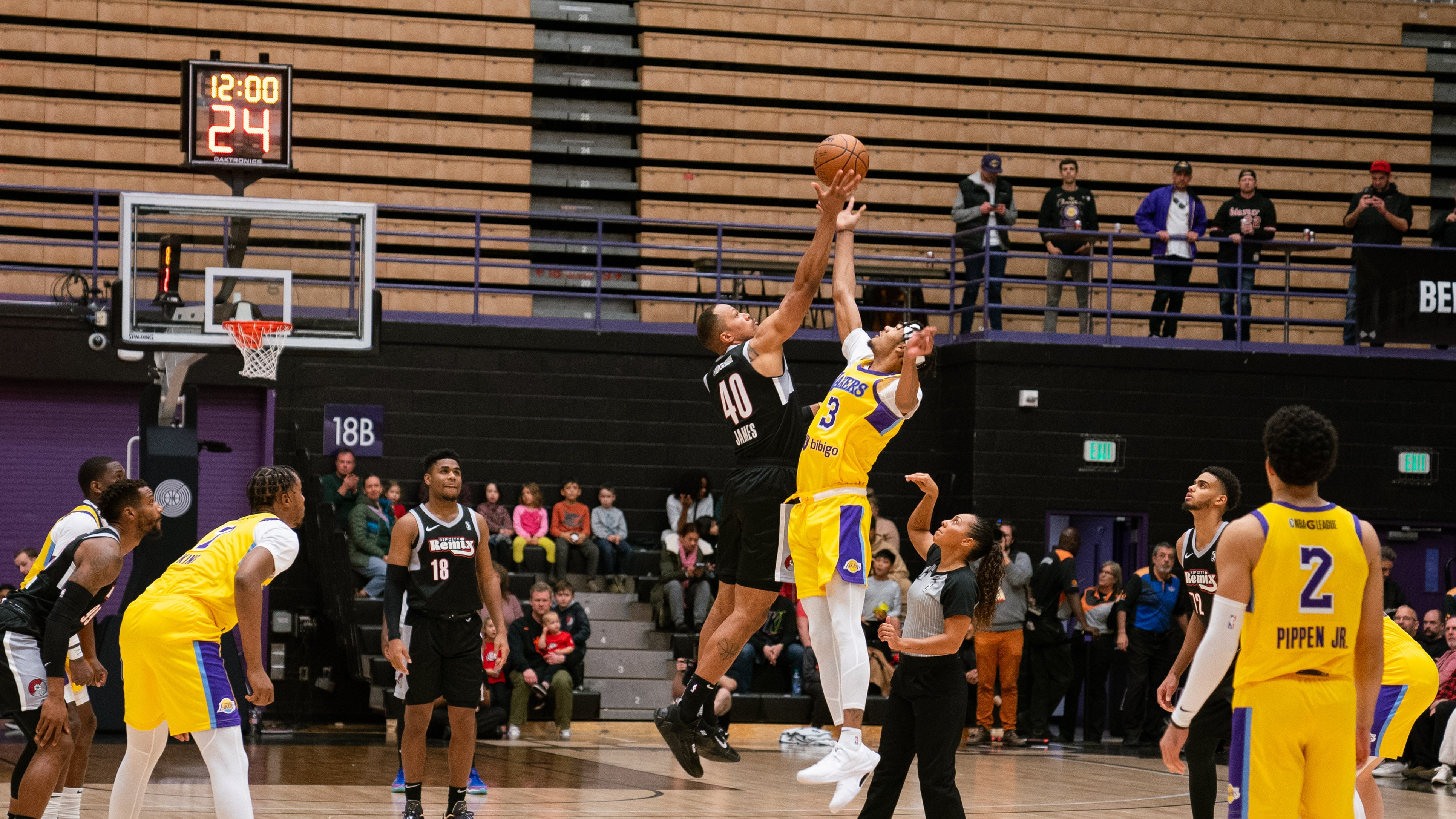The Rip City Remix, the Trail Blazers’ fledging minor league affiliate, is hoping to sell you a different experience than their parent club: a good, old-fashioned game of basketball.
The scene at the University of Portland’s Chiles Center is a decidedly non-digital experience. The video screen is hardly noticeable—the size of a large television rather than a small tennis court—and nobody’s asking you to download an app or place a bet. The hallways smell like popcorn, and you can see the expressions on players’ faces. Hot dogs and beer are each $7.
As the Blazers set out into life after Damian Lillard with more questions than answers, the front office has continued searching for players between the couch cushions of every league in the world. Ahead of this season, their efforts included finally getting around to setting up their own franchise in the NBA’s minor league, the G League, where a collection of veteran castoffs, teenagers who went pro early, small big men, and shooting guards who can’t shoot play a season of basketball for a cult following.
On the Monday before Thanksgiving when I took in my first G League game, one that saw the Remix host the Ontario, Calif., affiliate of the Clippers, the fans who had come out appeared curious about what they would see. Player intros started without the lights being brought down, and the public address announcer introduced the team’s starting center:
“...Moses Broooown!”
But there was no Moses Brown. Scattered applause was directed at his empty chair.
Brown, who had been talking to an assistant coach near the scorer’s table, sheepishly ran over to his teammates while the rest of the starting lineup was introduced: Jamaree Bouyea, a second-year point guard with a receding hairline; Jarrey Foster, a 26-year-old forward with two torn ACLs who refers to himself as a “Former Elite Athlete” on his own LinkedIn page; Kris Murray, a rookie first-round draft pick who’s found himself the odd man out in the Blazers’ rotation; and Rayan Rupert, a French 19-year-old snagged by the team with its second-round pick who looks like a very fierce baby deer.
The Remix and their counterparts from California’s 25th-largest city gathered at center court for the opening tip, which Brown won easily. Once a highly touted recruit out of Queens, Brown left UCLA after one season to turn pro but went undrafted. He’s had two stints with the Blazers and five with other NBA teams. The Remix is his sixth G League team.
Most players get far fewer chances than Brown has received so far, but most players aren’t anywhere near as gigantic (he’s listed at 7-foot-2, 260 pounds and has a reported 7-foot-4-inch wingspan). In a more intimate setting, he appears at least 11 feet tall.
Now 24 years old, Brown’s getting a little long in the tooth to still be considered a prospect. This might be his last good chance, and if it doesn’t work out in Portland, he’ll likely soon find himself in Greece or Turkey or China playing for slightly better money. If, however, he finally puts together all the pieces of his game, he could play 10 more seasons in the NBA and make something in the neighborhood of a hundred million dollars.
So it goes in the G League, where the stakes are high and the crowds are small.

Called the NBA Development League (“the D-League” colloquially) before Gatorade bought the naming rights in 2017, the G League comprises three kinds of players.
First, there are standard G Leaguers, who earn minimum salaries of $40,500 and have typically passed up more lucrative overseas contracts in order to stay within eyeshot of NBA scouts and general managers. Second, there are NBA players on assignment, usually younger prospects or players returning from injury (they still make NBA money). The third type are players on two-way contracts, which means they make about $500,000 and play a little bit for both teams.
For many years, the Blazers were one of the only teams in the NBA that didn’t have their own G League affiliate. After announcing the team’s creation last season, management stood their new franchise up quickly—at one point holding open tryouts in Portland and Seattle—and set up shop at the Chiles Center.
It seems to have been the right choice. The arena’s the right size, about 5,000 seats, and logistically feasible for fans, who can either park in the large lot next to the building or take the TriMet 44 bus, which stops on the same block.
Most seats are about $20 for adults, $5 for kids. There’s a little beer garden on the baseline that sells a Remix-branded IPA from Backwoods Brewing, and the DJ in the opposite corner keeps things humming. The PA guy, who also does Seahawks games, is terrific.
There were no Blazer players in attendance to see Moses Brown and company that night because the team was on the road, but I’d expect they’ll be in the building from time to time (a few were at the season opener in L.A.). Blazers’ GM Joe Cronin was there, however, sitting in the corner and giving off a sort of Thanos vibe.
The Remix led 59-47 at halftime, for which the players disappeared after ducking under a regular human-sized doorframe. The halftime entertainment lasted for about a minute and a half and consisted of two kids who looked about the same age as Rupert taking their military oaths of service.
Eventually, Moses Brown emerged through said doorframe with a smile on his face and walked over to fist-bump Cronin. He then came down to the opposite side of the floor and airballed his first practice free throw. He’d finish the game with 19 points, 11 rebounds and four blocks, showing throughout both why he’s in the G League and why he’s gotten so many chances. The Remix pulled away at the end to win behind guard Malachi Smith’s 26 points off the bench, but not before Moses Brown saw the Ghost of Christmas Yet to Come.
Dewayne Dedmon—34, veteran of more than 500 NBA games—logged four minutes for the Clippers and guarded Brown for a stretch.
Dedmon’s career began in the G League when he was Moses Brown’s age, though it was still called the D-League at the time. Now, with a little bit of gas left in the tank, he plays in small gyms for a small salary, staying in shape and waiting for one last call-up that may never come.
GO: The Rip City Remix begins a three-game homestand with a game against the Stockton Kings at the Chiles Center, 5000 N Willamette Blvd., ripcity.gleague.nba.com. 6 pm Thursday, Dec. 7. $10.
